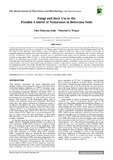Please use this identifier to cite or link to this item:
http://hdl.handle.net/10311/917Full metadata record
| DC Field | Value | Language |
|---|---|---|
| dc.contributor.author | Mubyana-John, T. | - |
| dc.contributor.author | Wright, M.G. | - |
| dc.date.accessioned | 2011-11-15T12:41:18Z | - |
| dc.date.available | 2011-11-15T12:41:18Z | - |
| dc.date.issued | 2011 | - |
| dc.identifier.citation | Mubyana-John, T. & Wright, M.G. (2011) Fungi and their use in the possible control of Nematodes in Botswana soils, The African Journal of Plant Science and Biotechnology | en_US |
| dc.identifier.issn | 1752-3931 (Print) | - |
| dc.identifier.uri | http://hdl.handle.net/10311/917 | - |
| dc.description.abstract | A study assessing fungi isolated from three climatic regions of Botswana as a possible control for root knot nematodes (Meloidogyne spp.) affecting the tomato(Lycopersicon esculentum L. var. ‘Money maker’) crops was conducted. Out of 1,250 soil fungal isolates, only 232 soil fungi from the Okavango Delta, Bobirwa district and different saltpans in Botswana could be sub cultured, and screened for antagonism against Meloidogyne sp. Seven of the isolates i.e., Trichoderma sp., Penicillium sp., Dendriphiopsis sp., Fusarium chlamydosporium, Cochliobolus sativus, Aspergillus fumigatus and an unidentified sterile fungus showed potential to immobilize nematode juveniles on agar plates within 2-4 days. C. sativus and Dendriphiopsis sp. showed maximum paralysis on agar plates and eventually death of the Meloidgyne sp. juveniles. In greenhouse studies using tomato plants the fungi alleviated the effect of nematodes by increasing plant, shoot height and root weight as compared to the reference controls. Cochliobolus sativus and Trichoderma sp. showed maximum plant protection of tomato plants under greenhouse conditions. Fungi ability to produce cellulase and chitinase were some of the mechanisms studied. The results indicated that Trichoderma sp., Penicillium sp., Dendriphiopsis sp., Fusarium chlamydosporium, Cochliobolus sativus and Aspergillus fumigatus are nematode antagonistic fungi indigenous to Botswana that can be used to control nematodes as they are better adapted in comparison to introduced fungi. | en_US |
| dc.language.iso | en | en_US |
| dc.publisher | Global Science Books, http://www.globalsciencebooks.info/ | en_US |
| dc.subject | Bobirwa | en_US |
| dc.subject | Cochliobolus | en_US |
| dc.subject | Meloidogyne | en_US |
| dc.subject | Trichoderma | en_US |
| dc.subject | Okavango | en_US |
| dc.subject | Saltpan | en_US |
| dc.subject | Tomato | en_US |
| dc.title | Fungi and their use in the possible control of Nematodes in Botswana soils | en_US |
| dc.type | Published Article | en_US |
| Appears in Collections: | Research articles (Dept of Biological Sciences) | |
Files in This Item:
| File | Description | Size | Format | |
|---|---|---|---|---|
| Mbuyana-John_AJPSB_2011.pdf | 794.14 kB | Adobe PDF |  View/Open |
Items in DSpace are protected by copyright, with all rights reserved, unless otherwise indicated.
